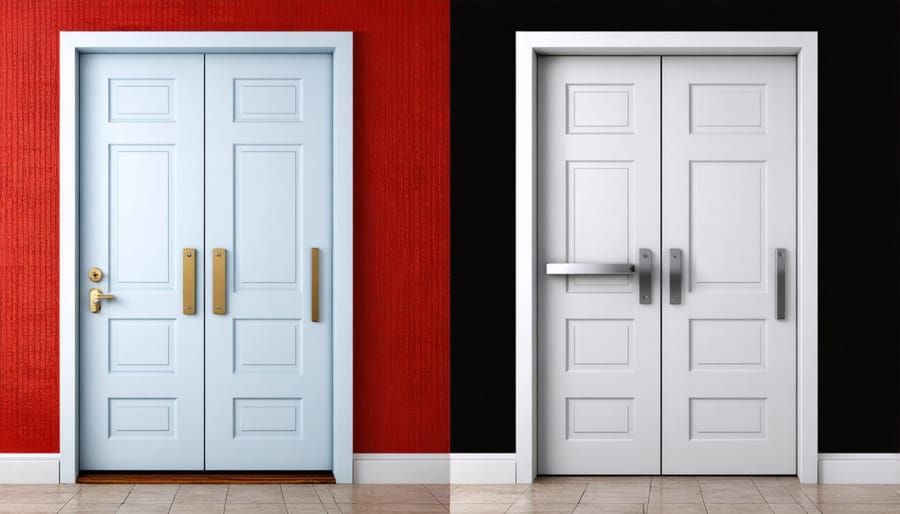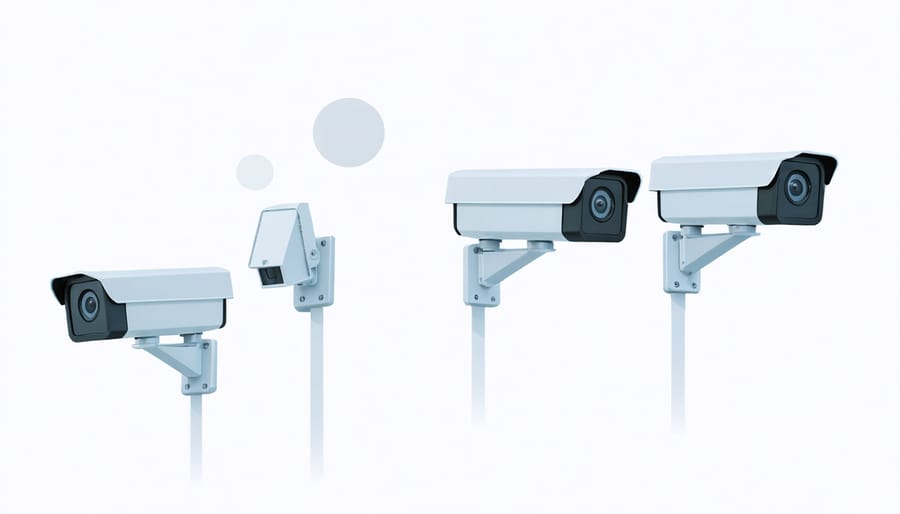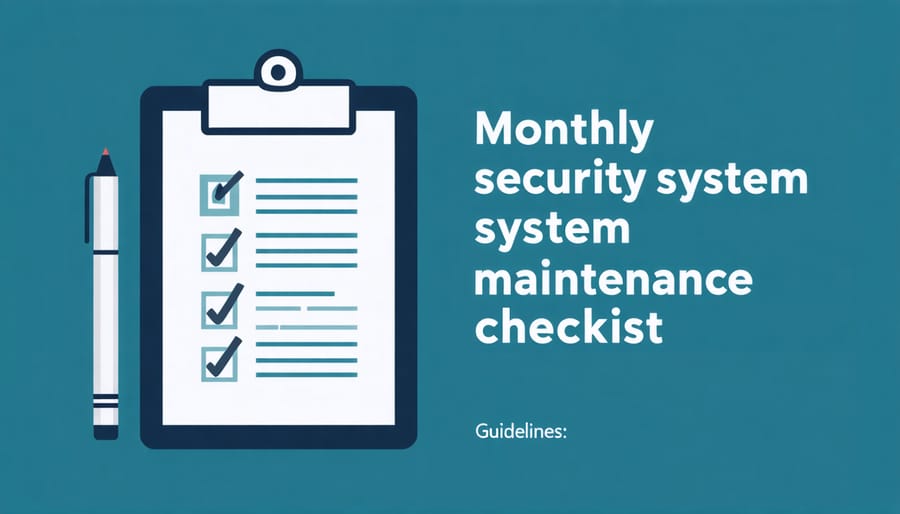Transform your home into a fortress without breaking the bank. Installing smart security begins with mastering essential home repair skills and implementing strategic defense layers. Start by reinforcing entry points with grade-1 deadbolts, door jammers, and window sensors that connect to your smartphone. Position motion-activated LED floods to illuminate shadowy corners, and install wireless security cameras at key vantage points – doorways, first-floor windows, and rear entries.
Create a comprehensive security network using affordable smart home devices that work together: door sensors that trigger cameras, motion detectors that activate lights, and doorbell cameras that record visitors. Modern DIY security systems offer professional-grade protection at a fraction of the cost, with no monthly fees or complex installation requirements. The best part? You can monitor and control everything from your phone, giving you peace of mind whether you’re in bed or across the country.
Essential Entry Point Protection
Door Security Upgrades
Your front door is your home’s first line of defense, and there are several easy DIY security upgrades you can implement to enhance its protection. Let’s start with the basics: reinforcing your door frame with a door reinforcement plate and longer screws. This simple modification can make your door significantly more resistant to forced entry.
Installing a deadbolt is another crucial upgrade. Choose a Grade 1 deadbolt with a minimum one-inch throw bolt for maximum security. When installing, ensure all screws penetrate the door frame and studs behind it. For added protection, consider a door devil or security strike plate that distributes force across a larger area of the frame.
Smart locks are becoming increasingly popular and offer convenient features like keyless entry and remote access control. Many models are surprisingly simple to install, requiring just a screwdriver and about 30 minutes of your time. Look for options that integrate with your existing smart home system for seamless automation.
Don’t forget about your door’s hinges! If they’re exposed on the outside, replace them with security hinges that have non-removable pins. Also, consider installing door sensors that alert you when the door opens – these typically stick on with adhesive and connect to your smartphone via WiFi.
For sliding doors, a simple security bar or charlie bar can prevent forced entry. Install track locks at the top and bottom of the door for additional security. Adding window film to any glass panels makes them more resistant to breaking.
Remember to maintain these security features regularly. Check that all components are properly aligned and functioning smoothly. Lubricate moving parts every six months, and test smart features monthly to ensure they’re working correctly. These small maintenance tasks will help ensure your door security upgrades continue to protect your home effectively.

Window Safety Solutions
Windows are often considered the most vulnerable entry points in your home, but with some simple DIY solutions, you can significantly enhance their security. Let’s explore some effective methods to protect your windows without breaking the bank.
Start with basic window locks, which are your first line of defense. Pin locks are particularly effective for double-hung windows – simply drill a small hole through the inner and outer frames and insert a removable pin. For sliding windows, installing track locks or dowel rods in the track prevents forced entry, even if the primary lock fails.
Consider installing window sensors as part of your security strategy. Modern wireless sensors are affordable and easy to install – they simply stick onto your window frame and connect to your smartphone via WiFi. When the window opens, you’ll receive an instant notification. Many of these sensors also include glass-break detection for added protection.
Reinforcement methods can make your windows significantly more resistant to break-ins. Security film is an excellent option – it’s essentially a clear, adhesive layer that holds glass together even when broken. Installation is straightforward: clean the window thoroughly, spray the glass with soapy water, apply the film, and squeeze out air bubbles with a squeegee.
For ground-floor windows, consider installing window bars or security screens. Modern options are both effective and aesthetically pleasing, with designs that complement various home styles. If you’re concerned about emergency exits, look for quick-release mechanisms that allow for easy escape from inside while maintaining security from outside.
Don’t forget about landscaping as a natural deterrent. Plant thorny bushes beneath windows, but keep them trimmed to eliminate hiding spots. Motion-sensor lights around windows are also excellent deterrents – they’re simple to install and can be solar-powered for energy efficiency.
Remember to regularly test all window security features and maintain them properly. Even the best security solutions can fail if they’re not checked and updated periodically.
Smart Security on a Budget

DIY Security Camera Systems
Setting up your own security camera system is a smart investment that integrates perfectly with other smart home automation solutions. With today’s technology, you can create a comprehensive surveillance system without breaking the bank.
Start by mapping out your camera placement strategy. Focus on key areas like entry points, driveways, and blind spots around your property. For optimal coverage, position cameras at a height of 8-10 feet, angling them slightly downward. This placement prevents tampering while maintaining clear visibility of faces and activities.
When selecting cameras, consider these essential features:
– Weather resistance for outdoor units
– Night vision capabilities
– Motion detection
– Two-way audio
– Wi-Fi connectivity
– Compatible mobile app support
For storage solutions, you have two main options. Local storage using microSD cards or a dedicated Network Video Recorder (NVR) keeps your footage private but has limited capacity. Cloud storage offers unlimited space and remote access but typically requires a monthly subscription. Many DIY enthusiasts opt for a hybrid approach, using local storage for immediate footage and cloud backup for important events.
Remote monitoring is where your DIY system truly shines. Modern security cameras connect to your home network, allowing you to view live feeds and receive notifications on your smartphone. Look for cameras with reliable apps that offer features like:
– Real-time alerts
– Video playback
– Custom motion zones
– Time-lapse viewing
– Multiple device access
To ensure reliable operation, connect your cameras to a dedicated Wi-Fi network or consider Power over Ethernet (PoE) cameras for stable, wired connections. Install a backup power supply to keep your system running during outages, and regularly test your setup to confirm all components are working correctly.
Remember to protect your camera system from cyber threats by:
– Using strong, unique passwords
– Enabling two-factor authentication
– Keeping firmware updated
– Securing your home network
With careful planning and implementation, your DIY security camera system can provide professional-level protection at a fraction of the cost of commercial installations.
Motion Sensors and Alarms
Motion sensors and alarms form the backbone of any effective DIY home security system. These devices act as your property’s vigilant guardians, instantly alerting you to unexpected movement in and around your home. The good news is that modern wireless motion sensors are surprisingly easy to install and configure yourself.
Start by identifying key placement areas: entryways, hallways, and large rooms with multiple access points. For optimal coverage, mount sensors at about 6-8 feet high in corners, ensuring they have a clear view of the space. Most wireless sensors come with adhesive strips or simple mounting brackets, making installation a breeze.
When selecting motion sensors, consider dual-technology models that combine passive infrared (PIR) and microwave detection. These reduce false alarms by requiring both technologies to trigger before sending an alert. For homes with pets, look for “pet-immune” sensors that won’t activate for animals under 40-80 pounds.
Modern motion detection systems connect to your smartphone via WiFi, sending instant notifications when movement is detected. Many also integrate with smart home platforms, allowing you to arm or disarm the system remotely. For added security, consider sensors with built-in cameras that capture snapshots or video clips when triggered.
Here’s a quick setup checklist:
– Test sensor batteries before installation
– Clean mounting surfaces thoroughly
– Avoid placing sensors near heat sources or direct sunlight
– Configure sensitivity settings to prevent false alarms
– Test the system thoroughly after installation
– Set up backup power options
Remember to strategically place your alarm sirens both inside and outside the house. Indoor sirens deter intruders, while outdoor ones alert neighbors. Most wireless systems offer multiple siren options, from subtle chimes to ear-piercing alarms.
For maximum effectiveness, combine motion sensors with door/window sensors and create customized zones within your home. This allows you to arm certain areas while leaving others accessible, perfect for nighttime security or when you’re home during the day.
Outdoor Security Measures
Landscape Security
Your landscape can be a powerful first line of defense in home security, combining beauty with functionality. Strategic plant placement can deter intruders while enhancing your home’s curb appeal. Consider planting thorny bushes like roses or holly beneath windows and along property boundaries – these natural barriers are both beautiful and effective deterrents.
Proper lighting is equally crucial for landscape security. Install motion-activated lights around entry points, walkways, and dark corners of your yard. Solar-powered options are cost-effective and easy to install without professional help. Position lights to eliminate potential hiding spots and ensure clear visibility of your property from the street.
Create defined boundaries using decorative fencing, hedges, or stone walls. This establishes clear property lines and creates psychological barriers for potential intruders. Low-growing plants near entrances and windows maintain visibility while taller specimens can provide privacy in backyard areas.
Maintain your landscape regularly to maximize security benefits. Trim bushes and tree branches that could provide cover for intruders or access to upper floors. Keep grass cut and remove dense undergrowth that could serve as hiding spots. Consider gravel or stone paths around your home’s perimeter – the crunching sound serves as a natural alarm system.
Smart landscape planning includes avoiding features that might aid intruders. Don’t place large decorative items like boulders or sturdy trellises near windows where they could be used as climbing aids. Instead, opt for smaller decorative elements and keep them away from access points.
Remember to coordinate your landscape lighting with your home’s overall security system. Timer-controlled lights can create the impression of occupancy when you’re away, while strategically placed cameras should have clear sightlines without obstruction from foliage or decorative elements.

Garage and Storage Protection
Your garage and outdoor storage areas often contain valuable items and can be potential entry points to your home. Let’s transform these spaces into secure zones with some simple DIY solutions.
Start with your garage door by installing a deadbolt or slide lock as a backup security measure. These manual locks provide an extra layer of protection when you’re away for extended periods. For automatic garage doors, consider adding a smart garage door opener that alerts you when the door opens and allows remote monitoring through your smartphone.
Motion-sensor lights are essential for deterring nighttime intruders. Install them above garage doors and around storage sheds, positioning them high enough to prevent tampering. Solar-powered options are great for areas without electrical access and can save on energy costs.
For storage sheds and outbuildings, invest in heavy-duty padlocks with shrouded shackles that resist bolt cutters. Reinforce door hinges with longer screws and install door jammers for additional security. Window security film on shed windows prevents break-ins while maintaining natural light.
Create a storage security checklist:
– Replace old or rusted locks
– Install battery-powered door/window alarms
– Secure valuable equipment with ground anchors and cables
– Mount a wireless security camera
– Keep areas well-lit and maintain clear sightlines
– Trim bushes and trees that could provide cover for intruders
Consider organizing your storage strategically. Keep expensive tools and equipment away from windows and store them in locked cabinets. Mark valuable items with your driver’s license number using an engraving tool – this makes them less attractive to thieves and easier to recover if stolen.
Remember to maintain your security measures regularly. Test alarms monthly, lubricate locks, and check that all lighting and cameras are functioning properly. These simple habits will ensure your garage and storage areas remain protected year-round.

Maintenance and Testing
Regular maintenance is crucial for ensuring your DIY security system remains effective and reliable. Just like any other home improvement project, your budget-friendly security solutions need consistent attention to stay in top shape.
Create a monthly maintenance checklist that includes testing all door and window sensors, checking camera alignments, and verifying that motion detectors are responding correctly. Test your security cameras during both day and night to ensure proper visibility and recording capabilities. Don’t forget to clean camera lenses and sensors regularly to prevent dust buildup that could affect their performance.
Battery-operated devices require special attention. Set calendar reminders to check and replace batteries every three to six months, depending on usage. For wireless components, verify signal strength and connection status regularly to prevent any unexpected disconnections.
If you’ve installed smart security devices, keep their firmware updated to protect against potential vulnerabilities and ensure optimal performance. Test your backup power systems quarterly to confirm they’ll work during power outages. Additionally, review and update your emergency contact list and ensure all family members know how to operate the system.
Seasonal changes can affect your security setup, so perform thorough checks during spring and fall. Adjust outdoor camera positions to account for growing vegetation and changing lighting conditions. Test weather-resistant equipment after severe storms to ensure everything’s functioning properly.
Remember to document all maintenance activities and keep a log of any issues you encounter. This record will help you identify patterns and address recurring problems before they compromise your home’s security.
Securing your home doesn’t have to be complicated or expensive. By implementing the DIY security measures we’ve discussed, you can significantly enhance your home’s safety while maintaining control over your security setup and budget. Remember to start with the basics: reinforcing entry points, installing proper lighting, and maintaining good visibility around your property. Layer your security approach by combining physical deterrents with smart technology solutions that fit your lifestyle and needs.
The beauty of DIY home security lies in its flexibility – you can start small and gradually build up your system as your needs and confidence grow. Whether you choose to focus on traditional methods like sturdy locks and security films or embrace modern solutions like smart cameras and motion sensors, the key is consistent implementation and regular maintenance.
Don’t forget to periodically review and update your security measures, especially as new technologies become available. Most importantly, involve all household members in your security practices to ensure everyone understands and follows the safety protocols you’ve put in place. With dedication and attention to detail, you can create a robust security system that provides peace of mind without breaking the bank.
